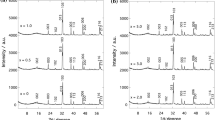Summary
The insertion of lithium(I) and zinc(II) into oxocuprates of superconducting compositions was achieved by novel solid-state reactions of LiI and ZnI2, in which copper is (formally) reduced and I2 liberated. In comparable insertions from solution, in which the accompanying oxidation of tetrathiafulvalence (yellow → red) acts as reaction indicator, magnesium(II), strontium(II), barium(II), manganese(II), zinc(II) and cadmium(II) are shown to be taken up. Nonincorporation of sodium(I) and larger M+ into the oxocuprates Y-123 and Bi-2212 (as well as a limitation of zinc(II) uptake into Y-123 cf. lithium(I), from the iodides) are attributable to cationic charge/size effects. XRD changes match those resulting from alternative copper-reduction processes. The relative redox potentials of lattice and complementary redox couple involved are important in governing the extent of cation uptake.
Similar content being viewed by others
References
C. N. R. Rao, J. Sol. State Chem., 74, 147 (1988).
H. Eickenbusch, W. Paulus, E. Gocke, J. F. March, H. Koch and R. Schöllhorn, Angew. Chem. Int. Ed. Engl., 26, 1188 (1987).
P. Rudolf and R. ScHöllhorn, J. Chem. Soc., Chem. Commun., 1158 (1992).
M. A. Alario-Franco, E. Morán, A. Várez, J. Santamaria and F. Sánchez-Quesada, Sol. State Ion., 44, 73 (1990).
Y. Koike, T. Okubo, A. Fujiwara, T. Noji and Y. Saito, Sol. State Commun., 79, 501 (1991).
L. Chen, A. van Zomeren and J. Schoonman, Sol. State Ion., 50, 55 (1992).
N. A. Fleischer, I. Lyubomirsky, Y. Scolnik and J. Manassen, Sol. State Ion., 59, 59 (1993).
N. A. Fleischer, J. Manassen, P. Coppens, P. Lee, Y. Gao and S. Greenbaum, Physica C, 190, 367 (1992).
W. J. Macklin, S. Claude, V. Brien and P. T. Moseley, J. Mater. Chem., 2, 439 (1992).
R. D. Shannon, Acta Crystallogr., A32, 751 (1976).
D. W. Murphy, P. A. Christian, F. J. DiSalvo and J. V. Waszczak, Inorg. Chem., 18, 2800 (1979).
G. A. Scholz and F. W. Boswell, Sol. State Commun., 74, 959 (1990).
W. Wong-Ng, H. McMurdie, B. Paretzkin, C. Hubbard and A. Dragoo, NBS(USA) JCPDS Grant-in-Aid Report, 1987.
R. A. Robinson and R. H. Stokes, Electrolyte Solutions, 2nd Edit., Butterworths, London, 1959, p. 125.
Author information
Authors and Affiliations
Rights and permissions
About this article
Cite this article
Toohey, M.J., Rosseinsky, D.R. & Green, S.J. Novel solid-state and solution-phase processes for the modification of high-temperature oxocuprate superconductors: cation dependence of reduction by iodide and by tetrathiafulvalene. Transition Met Chem 19, 302–304 (1994). https://doi.org/10.1007/BF00139098
Received:
Issue Date:
DOI: https://doi.org/10.1007/BF00139098




